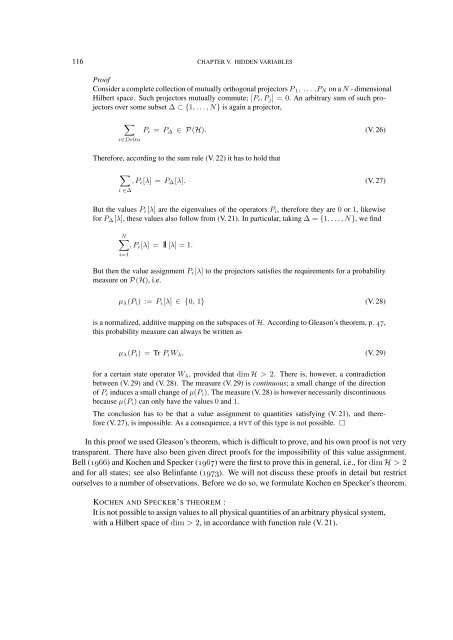FOUNDATIONS OF QUANTUM MECHANICS
FOUNDATIONS OF QUANTUM MECHANICS
FOUNDATIONS OF QUANTUM MECHANICS
You also want an ePaper? Increase the reach of your titles
YUMPU automatically turns print PDFs into web optimized ePapers that Google loves.
116 CHAPTER V. HIDDEN VARIABLES<br />
Proof<br />
Consider a complete collection of mutually orthogonal projectors P 1 , . . . ,P N on a N - dimensional<br />
Hilbert space. Such projectors mutually commute; [P i , P j ] = 0. An arbitrary sum of such projectors<br />
over some subset ∆ ⊂ {1, . . . , N} is again a projector,<br />
∑<br />
i∈Delta<br />
P i = P ∆ ∈ P (H). (V. 26)<br />
Therefore, according to the sum rule (V. 22) it has to hold that<br />
∑<br />
, P i [λ] = P ∆ [λ]. (V. 27)<br />
i ∈∆<br />
But the values P i [λ] are the eigenvalues of the operators P i , therefore they are 0 or 1, likewise<br />
for P ∆ [λ], these values also follow from (V. 21). In particular, taking ∆ = {1, . . . , N}, we find<br />
N∑<br />
, P i [λ] = 11[λ] = 1.<br />
i=1<br />
But then the value assignment P i [λ] to the projectors satisfies the requirements for a probability<br />
measure on P (H), i.e.<br />
µ λ (P i ) := P i [λ] ∈ {0, 1} (V. 28)<br />
is a normalized, additive mapping on the subspaces of H. According to Gleason’s theorem, p. 47,<br />
this probability measure can always be written as<br />
µ λ (P i ) = Tr P i W λ , (V. 29)<br />
for a certain state operator W λ , provided that dim H > 2. There is, however, a contradiction<br />
between (V. 29) and (V. 28). The measure (V. 29) is continuous; a small change of the direction<br />
of P i induces a small change of µ(P i ). The measure (V. 28) is however necessarily discontinuous<br />
because µ(P i ) can only have the values 0 and 1.<br />
The conclusion has to be that a value assignment to quantities satisfying (V. 21), and therefore<br />
(V. 27), is impossible. As a consequence, a HVT of this type is not possible. □<br />
In this proof we used Gleason’s theorem, which is difficult to prove, and his own proof is not very<br />
transparent. There have also been given direct proofs for the impossibility of this value assignment.<br />
Bell (1966) and Kochen and Specker (1967) were the first to prove this in general, i.e., for dim H > 2<br />
and for all states; see also Belinfante (1973). We will not discuss these proofs in detail but restrict<br />
ourselves to a number of observations. Before we do so, we formulate Kochen en Specker’s theorem.<br />
KOCHEN AND SPECKER’S THEOREM :<br />
It is not possible to assign values to all physical quantities of an arbitrary physical system,<br />
with a Hilbert space of dim > 2, in accordance with function rule (V. 21).
















